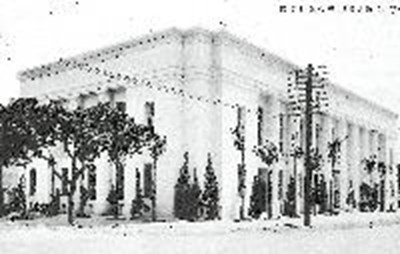
上架日期:2019/4/19
彰化銀行創設與總行沿革
彰化銀行創立於1905年(明治38年),由吳汝祥、吳德功、辜顯榮等中部仕紳1058人共同出資認股開辦,並由董事互選吳汝祥先生出任專務取締役(常務董事兼總經理)及日人坂本素魯哉出任支配人(經理)負責業務營運。
彰化銀行之開辦,究其本源,起於臺灣總督府對於臺灣土地租權與稅收之整頓。自清領以降,臺灣的土地逐漸出現一地二主的特殊現象。最早出資招募佃戶開墾土地的墾首,為土地的所有人,每年向土地上的佃戶收取定額的佃租,稱為大租戶。然而原承租土地的佃戶,亦可能將土地再包租給其他佃戶耕作,藉以收取土地租金,類同於今日租貸房屋時所謂的二房東,此稱為小租戶。
由於土地上有大租、小租,隨著時間流轉,數代人事興替、產權典質變賣之後,大租、小租所有權混淆不清,連帶導致執政者不知該向何人徵稅的棘手問題。清代劉銘傳為推動現代化建設,亟需臺灣土地稅收支持財政,遂著手清查田賦,將大租減四留六,即大租戶僅能向小租戶收取昔日六成的佃租,但不用再負擔繳稅義務。劉銘傳的政策,明訂由小租戶繳納土地稅賦,變相確立了臺灣土地以小租戶為業主的成例。
進入日治時期後,臺灣總督府對於大租、小租之稅收問題亦感頭痛,為徹底消彌一地二主的歷史問題,遂在劉銘傳以小租為土地業主的基礎上,於1904年(明治37年)頒佈整理大租權之律令,由總督府發行公債(償還期30年,利息5分)收購大租權,讓小租戶成為土地上唯一的地主,明確繳稅者之身分與義務。
然而,原大租戶在收到總督府發行的補償公債後,卻感到茫然不安,甚至產生社會動盪。原因在於,公債對於臺人是一個全新的概念,再加上當時正值日俄戰爭期間,臺人對於長達30年期的公債能否如期贖回缺乏信心。一時之間,削價求現、拋售公債的現象湧現,對臺灣總督府的威信與信任感產生強烈衝擊。為解決此一事態,總督府開始收購大租戶補償公債,穩定公債面值與社會人心。同時積極勸誘臺人仕紳以公債為抵押,向臺銀貸款開辦各種事業,彰化銀行也就此應運而生。
1905年(明治38年)彰化銀行開辦之初,是借用彰化廳官舍做為營業處,官方扶持色彩顯著,至1907年(明治40年),新建行舍落成方才遷出。1909年(明治42年),因地方行政官制革新,中部地區行政以臺中為核心,故彰銀收購臺中共立學校之校舍,修繕後設置臺中出張所(分行),並開始辦理經收臺中廳地方稅款業務。隔年股東常會更決議將總行由彰化遷至臺中,原彰化總行則改為彰化出張所,至此形成雖名彰化銀行,總行卻在臺中的有趣現象。
1935年(昭和10年),創立30週年的彰銀,經股東會決議新建一宏偉氣派的總行館舍,除徹底解決營業空間不足之外,更有彰顯30週年紀念之意。隔年,為配合工程期間之營運,先於對街修築臨時行舍,並委託總督府技師白倉好夫、畠山喜三郎設計規劃新總行館舍藍圖。1936年(昭和11年),總行於今址破土動工,由齋藤辰次郎承包工程,至1938年(昭和13年)落成啟用,成為現今所見的第三代彰化銀行總行。
被譽為戰後彰銀之父的林獻堂
林獻堂(1881-1956),名朝琛,諱大椿,字獻堂,號灌園,臺中霧峰人。自幼學習傳統儒學經史,即長喜讀中外譯書,尤受梁啟超所倡民族、民權等理念影響,逐漸醞釀出推動臺灣民族運動的理念。1907年(明治40年)遊日期間,於奈良旅社巧遇梁啟超,兩人藉由筆談與翻譯,討論臺灣人遭受殖民體制差別待遇,如何爭取自由、平等之議題。並在梁啟超的建議下,選擇以體制內改革的溫和路線,做為推動臺灣民族運動的大原則。
此後林獻堂積極涉入各項文化與政治活動。在文化活動方面,1910年(明治43年)加入詩社「櫟社」,成為該社重要成員與贊助者。1913年(大正2年)聯合臺灣仕紳,倡議設置培養臺籍子弟的學校,推動「臺灣公立臺中中學校(今臺中一中)」成立,後被譽為「創校五先賢」之一。1921年(大正10年)參與蔣渭水創立的「臺灣文化協會」,出任總理職務,在各地設置讀報社、舉辦文化演講會,努力普及時代新知,對臺灣民眾進行思想啟蒙。
政治活動方面,則於1914年(大正3年)年成立「同化會」,以推動文化為名義,試圖促進日人平等對待臺人。1921年(大正10年)更發動「臺灣議會設置請願運動」,要求設立臺灣議會,爭取臺人參與政治之權力。自1921至1934年止,不屈不撓逐年向日本帝國議會提出15次請願,最終雖未能如願,卻也影響臺灣總督府於1935年(昭和10年),開放州、市、街、庄議員半數改為民選,成為臺灣地方自治的肇始。
林獻堂除以日治時期臺灣民族運動領袖而廣為人知外,其一生與彰銀關係密切,前後擔任彰銀相關職務達46年之久。林獻堂於1908年(明治41年)成為彰銀股東,1911年(明治44年)獲選為監察役,開始參與彰銀營運之決策,後更成為彰銀臺人股東之代表性人物。例如1936年(昭和11年)董事會上,專務取締役坂本素魯哉推薦其弟坂本信道出任董事一職,林獻堂說:「世間指稱彰化銀行為坂本銀行,坂本專務取締役是否要做到名符其實而後已?」此事就不了了之。
二戰後,國府接收臺灣,彰化銀行內日人存款被視為日產接收,董事會於1946年成立「彰化商業銀行籌備處」,由林獻堂出任籌備主任。隔年1947年2月28日,舉行創立股東大會,由董事會推選林獻堂擔任董事長。3月1日彰銀正式改組,成為官民合股的省屬行庫。
二戰後臺灣百廢待舉,嚴重的通貨膨脹,致使物價飛漲,人心惶惶之餘,對於銀行也缺乏信賴感。對此,林獻堂提出「堅實經營、服務大眾」做為經營理念,以個人信譽為基礎,盡心盡力穩定彰銀經營,任內彰銀盈餘增達13倍,足見其傲人成就。
1949年,林獻堂因二二八事件,以治病為由避居日本。1952年辭退彰銀董事長職務,轉任高等顧問,至1956年在日逝世為止。彰銀為紀念林獻堂之貢獻,特於第三代彰化總行花園,設置林獻堂半身銅像,取代原安置於此的坂本素魯哉銅像,今日也成為後人講述、緬懷林獻堂事蹟的重要地點。
-
The Establishment of Chang Hwa Bank and the History of the Bank’s Headquarters
Chang Hwa Bank was jointly funded and established in Meji 38 (1905) by a total of 1,058 gentry from central Taiwan, including Wu Ju-Hsiang, Wu Te-kung, and Ku Hsien-jung. Sakamoto Soroya, a Japanese national, was appointed as the Bank’s procurator (general manager).
Chang Hwa Bank was founded at a time when the Governor-General of Taiwan was revamping Taiwan’s policies on property leasing rights and taxation. During Qing China's rule, the rights to many properties began to be owned by multiple proprietors at the same time. The first settler, also deemed the “owner” of the land,
was the initial investor who would recruit tenants to cultivate his land and then lease his land out to farmers called “primary tenants” for a fixed annual fee. These primary tenants were in turn allowed to rent their allotted land out to other farmers or “secondary tenants” whose rights were similar to those of today’s sublandlords.
As time passed and properties continued to be pawned or sold off to others, tenancy rights shifted over the generations. Ownership rights ultimately became so complicated and ambiguous that government administrations were often at a loss as to whom taxes should be collected from. During the Qing dynasty, when Liu Ming-chuan was laying down the foundation for Taiwan’s modern infrastructure, it became evident that funds needed to be procured through Taiwan’s property taxes. After Liu took stock of the land tax system, he directed the formulation of policies and decreed that 40% of the rent secondary tenants paid to their primary tenants shall be collected by the government in other words, primary tenants only received 60% of the rent they imposed on their tenants. This regulatory change, however, also meant they were no longer under the obligation to pay property taxes. Liu Ming-chuan's policies stipulated that the rent paid by secondary tenants to the government was considered property tax, inadvertently converting secondary tenants into co-proprietors of these lands.
The Governor-General of Taiwan under Japanese rule was equally troubled by this issue of ambiguous ownership between primary and secondary tenants, and sought to eliminate problems caused by old policies for good while building upon the system of secondary tenant proprietorship created by Liu Ming-chuan. In Meiji 37 (1904), the Governor-General proclaimed a decree addressing the property rights of primary tenants in which government bonds (30-year repayment period at an interest rate of 5% per annum) were issued to purchase these rights from them, thus establishing secondary tenants as the sole proprietors of their lands and making official their obligations as taxpayers.
However, even after receiving the government compensation bonds, the original primary tenants remained dissatisfied and insecure to the point of causing social unrest. This was because the concept of government bonds was new to theTaiwanese people. With the Japanese fighting in the ongoing Russo-Japanese War, the Taiwanese public were doubtful as to whether they would be able to receive their repayments within 30 years as promised. In the blink of an eye, payments were cut back and bonds were dumped, striking a major blow to the authority and trustworthiness of the Governor-General of Taiwan. In response to this turn of events, the Governor-General began to buy back compensation bonds from primary tenants to stabilize the face value of the bonds and restore the trust of the people. At the same time, they actively persuaded the Taiwanese gentry to use these bonds as mortgages to obtain loans from banks for establishing all varieties of business. This was the chain of events that led to the establishment of Chang Hwa Bank.
Chang Hwa Bank was initially housed in the administrative offices of Changhua Prefecture when it was first incepted in Meiji 38 (1905), evidencing the strong
government support it received. There the Bank remained until renovations for its new business location were completed in Meiji 40 (1907). Due to a reform in the local administrative system in Meiji 42 (1909), the main hub of central Taiwan’s affairs was relocated to Taichung. In response, Chang Hwa Bank purchased the school buildings of Taichung Middle School and remodeled them into the Taichung Branch (agency) for collecting the local taxes of Taichung Prefecture. In the following year, the Bank’s shareholders elected to relocate Headquarters from Changhua to Taichung, and renamed Chang Hwa Bank’s original head offices as Chang Hwa Branch. Chang Hwa Bank thus came to be based in Taichung despite the fact that its name suggests otherwise.
In Showa 10 (1935), in celebration of Chang Hwa’s 30th anniversary, the Bank’s shareholders elected to build a grand new structure to serve as Headquarters. This new building would eliminate pressing issues such as insufficient space for business operations and be at the same time of great commemorative value. In the following year, in coordination with its construction schedule, Chang Hwa Bank constructed temporary offices and commissioned Governor-General engineers Shirakura Yoshio and Hatakeyama Kisaburo to design the blueprints for its new headquarters. In Showa 11 (1936), construction for the new headquarters began at its current location under Tatsujirou Satou’s supervision, and was completed in Showa 13 (1938) the Bank reopened for business shortly thereafter. These premises are now the third and current location of Chang Hwa Bank’s Headquarters.
Lin Xian-tang, The Father of Post-War Chang Hwa Bank
Lin Xian-tang (1881-1956), given name Chao-chen, courtesy name Xian-tang, style name Guan-yuan, was born in Wufeng, Taichung. Famous for leading the Taiwanese nationalism movement during Japanese rule, his was throughout his entire life closely connected with Chang Hwa Bank, holding related positions within the bank for almost 46 years.
He became a shareholder of the Bank in Meiji 41 (1908) thereafter, he was appointed as a statutory auditor in Meiji 44 (1911) and began to partake in the operative plans of Chang Hwa Bank. He then became an iconic figure among the Taiwanese shareholders of Chang Hwa Bank, and was considered to be equal in status to his Japanese counterpart and competitor, Soroya Sakamoto. For instance, in a board of directors’ meeting held in Showa 11 (1936), Soroya Sakamoto recommended that his younger brother, Nobumichi Sakamoto, join their ranks. Lin Xian-tang immediately quipped back, saying, “The people already refer to Chang Hwa Bank as the Sakamoto Bank would you enforce this name further until it becomes exactly that?” And so, the proposition was dropped.
After the war, the Republic of China took control of Taiwan. Deposits made by the Japanese within the bank were expropriated as Japanese property, and the board of directors established the “Chang Hwa Commercial Bank Preparatory Office” in 1946 with Lin Xian-tang as its director. On February 28 of the following year (1947), the shareholders’ meeting was established, and the board elected Lin Xian-tang as chairman. Chang Hwa was subsequently restructured on March 1 and became a joint-stock provincial bank.
The day of the shareholders’ meeting of 1947 was coincidentally the day on which the February 28 Incident broke out. Yen Chia-kan, then chief of the Finance Department, happened to come to Taichung to attend the Chang Hwa Bank shareholders’ meeting with plans to visit Sun Moon Lake afterwards. The next day, however, the uprising had already spread to central Taiwan. With the roads blocked off and a fear of being targeted as a government official from a different province, he made his way to Lin Xian-tang’s home in Wufeng and took refuge there.
Unfortunately, news of Lin Xian-tang sheltering a foreign government official spread. Angry civilians surrounded the Lin residence and wrecked Yen Chia-kan’s car while some even attempted to break into the house. Lin Xian-tang then came forth, urging the mob to stand down in an extremely controlled and calm manner. Yen Chia-kan accepted sanctuary from the Lin family, and it wasn’t until March 12 that the uprising was quelled, after which Lin Xian-tang asked his second son, Lin Yu-lung, to escort Yen back north.
Although Lin Xian-tang was a firm defender of the foreign officials during the February 28 Incident and even offered his assistance in dealing with the aftermath of violence, he was viewed as a hindrance to the Nationalist government to the point where he was listed at the very top of “The February 28 Incident Register of Traitors.” He was eventually taken off the register, but continued to dispute the many autocratic policies of the Nationalist government. In 1949, he was even discreetly requested to voluntarily resign from his position as chairman of Chang Hwa Bank. Ultimately, in September of the same year, Lin Xian-tang set off for Japan
for treatment of alleged health problems, where he turned to the General Headquarters of the Allied occupation of Japan to seek asylum as a political refugee and was subsequently granted long-term residence. In 1952, he resigned from his position of chairman at Chang Hwa Bank and became one of the Bank’s high-level consultants, remaining as such until his passing.
Although he was generally known as the leader of the Japanese resistance, Lin Xian-tang remained in Japan for the better part of his later years, as if in sharp criticism of the Nationalist government’s hypocritical ways. Even though the government sent many representatives to urge Lin Xian-tang to return to Taiwan, he could not be persuaded. This continued until the government sent Cai Pei-huo, Lin Xian-tang’s comrade in the resistance, to Japan in 1955 to coax him into compliance. Cai Pei-huo’s insistent pestering eventually angered Lin Xian-tang into proclaiming:
Enter not a nation of danger dwell not in a nation of strife. Forget not this harsh lesson instilled in us by our venerated forefathers. Taiwan is a nation of danger and strife, a place we shall not enter nor dwell within. Not only is it a place of peril and conflict, but also one devoid of all law and order where Chiang Kai-shek takes life and property at his will and pleasure. Should I ever return to this godforsaken land, I shall be no better than a caged chicken ready for slaughter.[1]
In the face of Lin Xian-tang’s brutal wrath, Cai Pei-huo had no choice but to make a hasty retreat. Those who lived through the tragedies engendered by the Order of Martial law were truly “caged birds.” In 1956, Lin Xian-tang died of illness in Japan. Yen Chia-kan saw to it that he was the one to personally meet Lin’s coffin when it was transported back to Taiwan and attended his funeral from start to finish in commemoration of their camaraderie and all the trials they had faced together.
________________________________________
[1] Referenced from the Taiwanese Journal Archive of the Academia Sinica. “The Diary of Mister Guan-yuan,” October 14, 1955. Link: https://goo.gl/1JfwbV, accessed: December 3, 2017.

 Facebook
Facebook
 Twitter
Twitter
 LINE
LINE